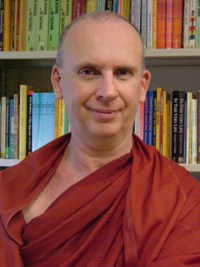The Digha Nikaya records that
before the Buddha passed away he ate a meal given to him by a blacksmith named
Cunda. This meal consisted of a preparation called sukara maddava which
can be translated as ‘pig’s delight’ (D.II,127). The ancient commentaries to
the Buddhist scriptures, the Sumangalavilasani
and the Paramatthajotika, give a
variety of explanations as to what this food was: tender fatty pork, bamboo shoots, a rice
preparation, etc. Obviously the identity of sukara
maddava was forgotten very early and later Buddhists had to resort to
guesswork. The earliest Buddhists
probably did not preserve information about sukara
maddava because quite correctly they thought it unimportant. There has been
a great deal of speculation of late as to what the Buddha’s last meal was.
Scholars such as Arthur Waley, E. J. Thomas and J. F. Fleet, Walpola Rahula, R.
Gordon Wasson, Karl Neumann and most
recently Thich Nhat Hanh, have
all weighed in on the subject. Adding to all this are the opinions of numerous
amateurs, usually ignorant of the Buddhist scriptures, ancient Indian social
history and much else besides. Some have said
sukara maddava was a pork
dish, which is quite possible as the Buddha was not a vegetarian. One of the
more bizarre theories and one that has gained wide acceptance is that it was a
type of truffle.
Early European scholars of
Buddhism theorized that because the French use trained pigs to find truffles,
the ‘pig’s delight’ mentioned in the Buddhist scriptures might be a variety of
truffle. This theory is based on the false premise that what is so of the
French countryside in the 19th century must have been so in India in the 5th
century BCE. In fact, truffles do not grow in India
and the use of trained pigs to find them even in France is a recent practice. Thus
the theory that the Buddha’s last meal was truffles is without any foundation. Equally
unfounded theories, presumably derived from this first one, is that sukara maddava
was a type of mushroom, that the Buddha died of eating poison mushrooms, from
food poisoning or even that he was poisoned. Again, the facts contradict such
fanciful speculations.
While acknowledging that the
matter is obscure and unlikely ever be settled, the general consensus amongst
scholars is that sukara maddava may have been some kind of pork dish.
Partisans of vegetarianism vehemently deny this and insist that it was truffles
or mushrooms or at least not meat. Those who mistakenly think that
vegetarianism was an integral part of early Buddhism jump to the conclusion that
the Buddha was contradicting his own teachings by eating meat, and accuse the truffle/mushroom
party of denying the obvious and trying to perpetuate a cover-up. Religious
zealots intent on replacing Buddhism with their own faith prefer the ‘Buddha
was poisoned’ scenario as it introduces a sinister aspect into the Buddha’s
life and mission. All we can say with certainty is that sukara maddava
was some kind of culinary preparation, the ingredients of which have long ago
been forgotten.
Now let’s just look at the facts.
In the months before his passing the Buddha had suffered “a severe illness causing him sharp pains as if
he were to die” and which he “endured
mindfully, fully aware and without complaint.” (Digha Nikaya II,99). This took place during
the monsoon when even in India
today water-born diseases are very common. The Buddha was 80 years old,
unusually long-lived for the time, and Ananda described him at this stage as having “slack and wrinkled limbs and being stooped.” (Samyutta Nikaya V,217). He himself said that
his body could “only be kept going by
being patched up.” (Digha Nikaya II,100). After his last meal, he had a
severe bout of “diarrhea with blood” (lohita pakkhandika), a
continuation of the sickness he had been suffering
from for some time, and later the next day he passed away. Obviously the Buddha
died of the typical complications brought on by exhaustion, sickness and old
age, not because of
what he had eaten the day before. This more sound conclusion was still current
when the Milindapanha was written (2nd
century BCE – 1st century CE). It says; “It was not from the food
that the Lord became sick. It was because of the natural weakness of his body
and the completion of his lifespan that the sickness grew worse.” (Milindapanha
175).
From the Buddhist perspective the
only significance of the Buddha’s last meal is that it demonstrated once again
his infinite capacity for compassion. When
he realized that the end was near, he immediately thought that Cunda might be
blamed for causing his death. To prevent this from happening he instructed Ananda to return to Cunda’s village and tell
him that to serve an enlightened one his last meal was a most auspicious and
blessed act. Thus, even being sick, exhausted and nearing death the Buddha’s
only thought was for the welfare of others.
This is the last of my posts on
Buddhism and vegetarianism. I am leaving for India tomorrow and will post again
after Christmas.










4 comments:
Beautiful! Thank you for this. Safe journeys and have a fruitful pilgrimage.
In the Dhamma,
Visakha and Ken
Happy travels, Bhante!
TkQ Bhante for your dhamma explanation .
Have a safe pilgrimage.
Thanks bhante,,,
happy christmas..
Post a Comment